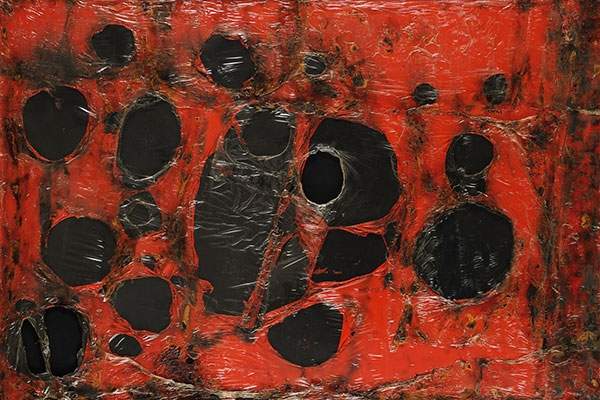Alberto Burri (Città di Castello, 1915 - Nice, 1995) will be the protagonist, from May 10 to July 28, 2019, of the exhibition BURRI la pittura, irriducibile presenza, a retrospective organized in Venice by the Giorgio Cini Foundation and the Burri Foundation in collaboration with Tornabuoni Art and Paola Sapone MCIA. From the very rare Catrami (1948) to the last and monumental Cellotex (1994), BURRI la pittura, irriducibile presenza with about 50 works from important Italian and foreign museums, the Burri Foundation and prestigious private collections, reconstructs in its entirety the historical parabola of one of the greatest great protagonists of 20th-century Italian and European art, and brings Burri back to Venice after the memorable solo exhibition that in 1983 featured 18 works from the Sestante cycle in the evocative building of the former Cantieri Navali at Giudecca, marking a milestone in the artist’s career
Curated by Bruno Corà, president of the Fondazione Burri, the exhibition will be held from May 10 to July 28 on the island of San Giorgio Maggiore in Venice and will chronologically retrace the most significant stages of the Master of “matter’s” career by exhibiting many of his most important masterpieces: from the extremely rare Catrami (1948) to Molds (1948), from the iconic Sacchi (1949-50), to Gobbi (1950), passing through Combustioni (1953), Legni (1955), Ferri (1958), the contorted Plastiche (1960) and the extraordinary evolution of Cretti (1970), all the way to Cellotex, made until the mid-1990s.
The aim of the exhibition, whose title refers to the artist’s own famous definition of his work and the difficulty of translating it into words, is to offer a penetrating reading of the way in which this pioneer of the new painting of the second half of the twentieth century dealt with the central theme of his time: that of the use and transformation of matter into a work of art.
“A quarter of a century after his death in 1995, the exhibition highlights the transformation brought by Burri to 20th-century art,” Corà explains. “It is not improper to compare the linguistic innovation introduced by Burri, with the systematic ’presentation’ of real matter in place of representational mimesis, to the Giottesque revolution accomplished in replacing the golden skies of medieval painting with the celestial that could be observed in nature. In both innovations the ’real’ was being introduced into painting instead of the imitative fiction of it. The shock produced by Burri in the immediate postwar years can only be measured by the effect achieved in the whole arc of artistic experiences he influenced: from the New Dada of Rauschenberg, Jonhs and Dine, to the Nouveau Réalisme of Klein, César, Arman and Rotella, from the Arte Povera of Pistoletto, Kounellis, Pascali and Calzolari to process art and up to monochrome-based neo-minimalism.”
Completing the exhibition is a multimedia documentary section of the artist’s entire activity, which also includes some rare films depicting him in action, the bilingual (Italian-English) catalog, introduced by a critical essay by curator Bruno Corà, and Luca Massimo Barbero, director of theGiorgio Cini Foundation’s Institute of Art History, which will contain a repertory of all the images of the works and will thus offer renewed tools for understanding the work and profile of the artist himself, also thanks to a fully updated bibliographical section. The installation is realized by Archea Associati. For all info, it is possible to visit the Cini Foundation website.
Pictured: Alberto Burri: Rosso Plastica M3 (1961; plastic, combustion on canvas)
 |
| The whole story of Alberto Burri in a major retrospective, from Catrami to Cellotex, in Venice |
Warning: the translation into English of the original Italian article was created using automatic tools. We undertake to review all articles, but we do not guarantee the total absence of inaccuracies in the translation due to the program. You can find the original by clicking on the ITA button. If you find any mistake,please contact us.